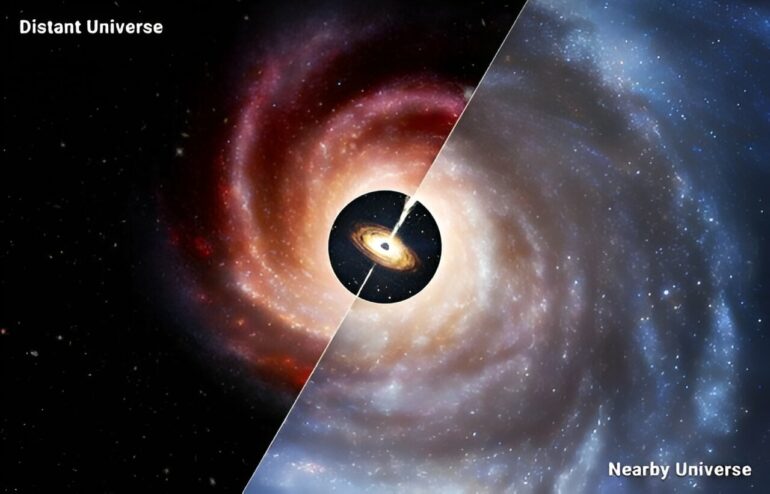Astronomers have discovered that the supermassive black holes in the centers of early galaxies are much more massive than expected. These surprisingly hefty black holes offer new insights into the origins of all supermassive black holes, as well as the earliest stages of their host galaxy’s lives.
In nearby, mature galaxies like our Milky Way, the total mass of stars vastly outweighs the mass of the big black hole found at the galaxy’s center by about 1,000 to 1. In the newfound distant galaxies, however, that mass difference drops to 100 or 10 to 1, and even to 1 to 1, meaning the black hole can equal the combined mass of its host galaxy’s stars.
This picture of unexpectedly massive black holes in fledgling galaxies comes from the James Webb Space Telescope (JWST), NASA’s latest flagship observatory. Until JWST, which launched in late 2021, astronomers were generally limited in their studies of distant black holes to stupendously bright quasars, composed of monster, matter-devouring black holes that completely outshine the stars in their host galaxies.
“With JWST, we can now finally observe lower-mass, yet still supermassive black holes in small, faraway galaxies, and we can see the stars in these host galaxies as well,” says Fabio Pacucci, a Clay Fellow at the Center for Astrophysics | Harvard & Smithsonian (CfA). “This allows us to study, for the first time, early black holes and their host galaxies as they evolve together.”
Pacucci is the lead author of a new study published in The Astrophysical Journal Letters reporting the findings, and has presented these results at the 243rd meeting of the American Astronomical Society in New Orleans, LA.
“We have learned that distant, young galaxies violate the relation between black hole mass and stellar mass that is very well established in nearby, mature galaxies: these primeval black holes are undoubtedly overmassive relative to the stellar population of their hosts,” says Roberto Maiolino, a professor at the University of Cambridge (UK), and co-author of the study. “With JWST, it will be possible to pinpoint how the first supermassive black holes formed by finding black holes that are farther and smaller than those found so far, and which our study predicts to be quite abundant.”
For the study, Pacucci and colleagues performed a statistical analysis of a set of 21 galaxies, ranging from about 12 to 13 billion light-years away, and observed through three published JWST surveys.
These 21 galaxies harbor central black holes with typical masses estimated to be tens or hundreds of millions of times that of our sun—still supermassive, but comparatively puny next to the black holes powering most of the distant quasars observed to date, which boast billions of times the sun’s mass.
“Overall, we see that black holes in the young galaxies observed by JWST are about ten to a hundred times more massive than the scaling relation in the local universe predicts,” says Xiaohui Fan, a professor at the University of Arizona, and co-author of the study. “The ratio of stellar mass to black hole mass in early galaxies was much lower back then, more than a dozen billion years ago, compared to now. This result has important implications for the study of the first population of black holes.”
Accurately estimating this ratio should help indicate how supermassive black hole precursors—dubbed black hole seeds—originated. Broadly, astronomers have sketched out two main pathways: “light” or “heavy” seeds.
Light black hole seeds would have been relatively low in mass, about 100 to 1,000 times the sun’s mass. These light seeds would have formed as remnants of the universe’s very first, colossal stars. At the other end, heavy black hole seeds would have started out around 10,000 to 100,000 solar masses. Such hefty seeds theoretically arose from the direct gravitational collapse of titanic gas clouds.
The heavy seed route, by setting the stage for growth from a much higher starting point, should facilitate the timely formation of the very early supermassive black holes that the team of researchers have discovered in the last twenty years at progressively greater distances. The new findings of overmassive black holes lend credence to the heavy seed idea, because simulations and theoretical calculations of this pathway predict that black holes should be roughly as massive or even more massive than the stellar component of the young galaxies they live in.
How galaxies then took shape and co-evolved around the primeval black hole seeds remains a wide-open astrophysical question. Did the black holes grow mostly via pulling in gas, or via mergers with other black holes? And did the stellar mass build up mostly within the galaxy, or were mergers with other, bigger galaxies needed? Pacucci and this team expect that answers will begin to materialize, though, with additional JWST studies.
“Over cosmic time, we know that the ratio of stellar to black hole mass progressively catches up with the local 1,000 to 1 ratio of the modern universe. This happens as the black hole and its host galactic system evolve together, merging with other galaxies and forming legions of stars,” says Pacucci. “What we’re still working on is seeing deeply enough into the universe to piece together how this all got started.”
In addition to Xiaohui Fan and Roberto Maiolino, the co-authors of the paper are Bao Nguyen from the University of Arizona and Stefano Carniani from Scuola Normale Superiore in Pisa, Italy. The JWST surveys used were the JWST Advanced Deep Extragalactic Survey (JADES), Cosmic Evolution Early Release Science Survey (CEERS), and the Galaxy Assembly with NIRSpec IFS survey (GA-NIFS).
More information:
Fabio Pacucci et al, JWST CEERS and JADES Active Galaxies at z = 4–7 Violate the Local M •–M ⋆ Relation at >3σ: Implications for Low-mass Black Holes and Seeding Models, The Astrophysical Journal Letters (2023). DOI: 10.3847/2041-8213/ad0158
Provided by
Harvard-Smithsonian Center for Astrophysics
Citation:
Unexpectedly massive black holes dominate small galaxies in the distant universe (2024, January 9)



